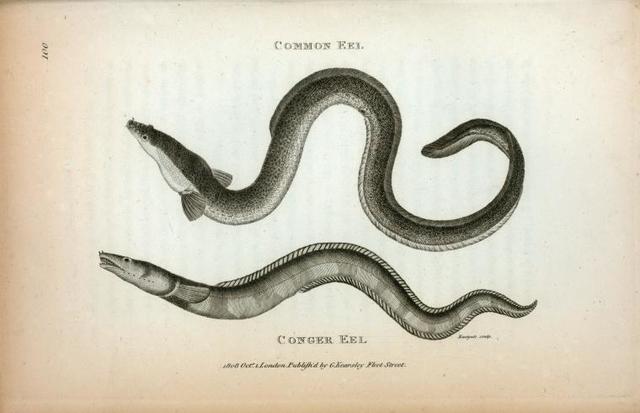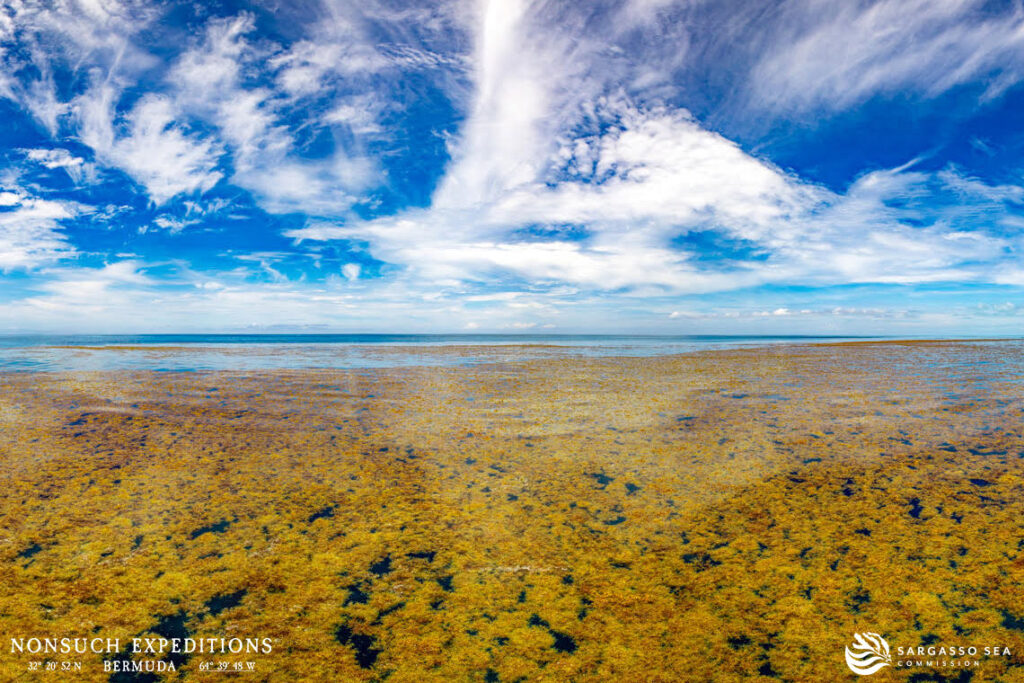Do eels really come from the Bermuda Triangle?
For thousands of years humans had absolutely no idea where eels came from, and some of the theories we came up with were pretty wild. Going back a few thousand years, the Ancient Egyptians believed eels spawned in the Nile when the water was warmed by the rays of the sun. And Ancient Roman naturalist Pliny the Elder (who wrote the 37-volume Naturalis Historia) concluded that baby eels were born from particles of adult eels that had been rubbed off of their body on rocks. We really didn’t know any better. Eels just kind of appeared with no evidence as to how or why.

So the Ancient Greeks took it a step further by classifying animals with unknown reproductive practices as reproducing via ‘spontaneous generation’, including the eel. Aristotle wrote that:
[eels] grow spontaneously in mud and in humid ground; in fact, eels have at times been seen to emerge out of earthworms, and on other occasions have been rendered visible when the earthworms were laid open by either scraping or cutting. (source)
While we recognise now that Aristotle was definitely not correct about this, the idea of spontaneous generation was taken seriously for quite a while. Any animal that didn’t have any obvious reproductive evidence available was automatically put on the list of animals that ‘spontaneously generate’. Over time, animals were removed from the list once reproductive practices were studied and understood. While the idea of life spontaneously appearing seems like a purely-ancient idea, the concept persisted through the middle ages and well into the nineteenth-century. Until at least 1870 the idea of spontaneous generation was still of interest to the British Association for the Advancement of Science.
On his deathbed in 1874, German microscopic anatomist Max Johann Sigismund Schultze confessed that other than the ‘eel question’, everything else was already known to science. And in 1876 Sigmund Freud studied and dissected 400 eels over the course of four months in an attempt to understand the reproductive nature of the eel. His research was in vain and he failed to uncover the answer to the ‘eel question’. Over and over again, scientists tried to understand why eels seemingly appeared out of thin air in lakes and rivers. Mating hadn’t been observed and reproductive organs hadn’t been discovered. So where were eels actually coming from?
From the lakes of Europe to the Bermuda Triangle
In the early twentieth-century, Danish biologist Johannes Schmidt began his nineteen-year journey to discover the mysterious origin of the eel, which he traced back for the first time to the Sargasso Sea. And where is the Sargasso Sea located? It just so happens to intersect with one of the most well-known sites of marine urban legend – The Bermuda Triangle.
This has obviously piqued the interest of many netizens who may have never given a second thought about the migratory path of eels. And I don’t say that critically, because I’m one of those people. The only reason the eel mystery came on my radar was because my husband showed me a TikTok that claimed they came from the Bermuda Triangle. It sounded a bit fishy (pun intended), so I looked into it and was surprised to find that it was actually somewhat true. But before we go pointing our fingers at aliens or magnetic fields, let’s look at what this actually means.


As shown in the images above (source/source), the Bermuda Triangle and the Sargasso Sea overlap roughly around Bermuda. So while it’s technically true that the origins of eels have been traced back to the Bermuda Triangle, the focus on their origin is more rightfully given to the Sargasso Sea.
Located in the Atlantic Ocean, the two million square mile Sargasso Sea is the only sea in the world that doesn’t have any land borders. The sea was named after the Sargassum seaweed that forms island-like masses on the water’s surface. It’s a unique and beautiful location, described by Greenpeace as “a place full of wonder; a golden floating rainforest home to turtles and whales and a nursery for even more incredible creatures”. The Sargassum seaweed acts as an excellent habitat and breeding ground for an array of creatures, including eels, sharks, and a variety of fish. It also acts as a migratory corridor for sharks, dolphins, rays, and whales. So why the specific focus on eels?

In 2022 scientists at the Environment Agency were finally able to confirm with satelite tags that, without a doubt, eels are migrating to the Sargasso Sea. This effectively concluded that Johannes Schmidt’s research was correct, and we now have proof thanks to technology not available to him a hundred years ago. The life cycle of the eel now appears to begin with birth in the Sargasso Sea, followed by drifting for two to three years back to Europe as glass eels, and maturing in fresh water before partaking in the 10,000km, year-long journey back to the Sargasso Sea where they breed and die. Rinse and repeat. Eels hadn’t been observed mating in European lakes because they simply saved this portion of their life cycle for the Sargasso Sea. This information has become critical to scientists who have noticed a concerning 95% decline in European eel populations since the 1980s. There is now a light at the end of the tunnel for the critically endangered European eel whose breeding ground can now be targeted by conservation efforts.
While mysteries based on conspiracies and fringe beliefs are incredibly entertaining, mysteries that deal with the natural world can be just as fascinating. And even something as seemingly simple as the migratory paths of the eel can leave even top scientists scratching their heads for thousands of years. So do eels come from the Bermuda Triangle? Yes, but you’re unlikely to find any paranormal tie between the fabled ship graveyard and Europe’s population of eels partaking in a cycle of birth, sex, and death nearby.
Sources and Additional Reading
BBC News – Ancient eel migration mystery unravelled (2022)
European Marine Biological Resource Centre – Sigmund Freud, from the eel testis to neurons and psychoanalysis (2021)
Gov.uk – Ancient mystery of European eel migration unravelled to help combat decline of critically endangered species (2022)
Green Peace – The Sargasso Sea: why this ‘golden floating rainforest’ urgently needs protecting (2024)
NOAA Ocean Exploration – The Importance of Exploring the Sargasso Sea: ‘Spiritual and Aesthetic Delight’ as Well as Conservation (2021)
Smithsonian Museum – The Utterly Engrossing Search for the Origin of Eels (2022)
Spontaneous Generation and Kindred Notions in Antiquity by Dr Eugene S McCartney, Northwestern University (1920)
The New Yorker – Where Do Eels Come From? (2020)
Wikipedia – Sargasso Sea / Elver Pass / Bermuda Triangle
